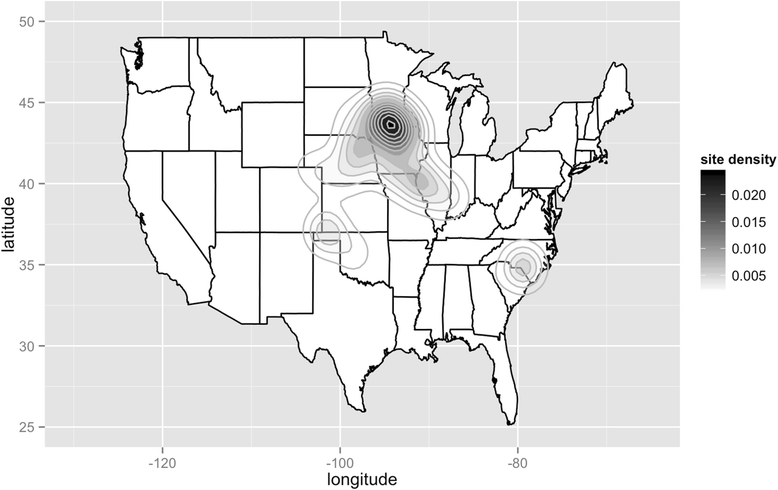Novel analytic tools for the study of porcine reproductive and respiratory syndrome virus (PRRSv) in endemic settings: lessons learned in the U.S
- PMID: 28405429
- PMCID: PMC5382381
- DOI: 10.1186/s40813-016-0019-0
Novel analytic tools for the study of porcine reproductive and respiratory syndrome virus (PRRSv) in endemic settings: lessons learned in the U.S
Abstract
Since its emergence in the late 1980's, the porcine reproductive and respiratory syndrome virus (PRRSv) has posed a significant challenge to the pig industry worldwide. Since then, a number of epidemiological tools have been created to support control and eventual elimination of the disease at the farm and regional levels. Still, many aspects of the disease dynamics are yet-to-be elucidated, such as what are the economically optimal control strategies at the farm and regional level, what is the role that the voluntary regional control programs may play, how to optimize the use of molecular tools for surveillance and monitoring in infected settings, what is the full impact of the disease in a farm, or what is the relative contribution of alternative transmission routes on the occurrence of PRRSv outbreaks. Here, we summarize a number of projects demonstrating the use of novel analytical tools in the assessment of PRRSv epidemiology in the United States. Results presented demonstrate how quantitative analysis of routinely collected data may help in understanding regional epidemiology of PRRSv and to quantify its full impact, and how the integration of phylodynamic methods as a standard tool for molecular surveillance of PRRSv might help to inform control and prevention strategies in high-risk epidemiological situations. Ultimately, these tools will help to support PRRSv control at farm and regional levels in endemically infected settings.
Keywords: PRRS; control; epidemiology; phylogenetics; production; regional projects.
Figures
Similar articles
-
Surveillance of porcine reproductive and respiratory syndrome virus in the United States using risk mapping and species distribution modeling.Prev Vet Med. 2018 Feb 1;150:135-142. doi: 10.1016/j.prevetmed.2017.11.011. Epub 2017 Nov 16. Prev Vet Med. 2018. PMID: 29169685
-
Spatiotemporal relative risk distribution of porcine reproductive and respiratory syndrome virus in the United States.Front Vet Sci. 2023 Jun 29;10:1158306. doi: 10.3389/fvets.2023.1158306. eCollection 2023. Front Vet Sci. 2023. PMID: 37456959 Free PMC article.
-
Modelling and assessing additional transmission routes for porcine reproductive and respiratory syndrome virus: Vehicle movements and feed ingredients.Transbound Emerg Dis. 2022 Sep;69(5):e1549-e1560. doi: 10.1111/tbed.14488. Epub 2022 Mar 3. Transbound Emerg Dis. 2022. PMID: 35188711 Free PMC article.
-
Immune Control of PRRS: Lessons to be Learned and Possible Ways Forward.Front Vet Sci. 2014 Oct 14;1:2. doi: 10.3389/fvets.2014.00002. eCollection 2014. Front Vet Sci. 2014. PMID: 26664910 Free PMC article. Review.
-
A Review of Quantitative Tools Used to Assess the Epidemiology of Porcine Reproductive and Respiratory Syndrome in U.S. Swine Farms Using Dr. Morrison's Swine Health Monitoring Program Data.Front Vet Sci. 2017 Jun 27;4:94. doi: 10.3389/fvets.2017.00094. eCollection 2017. Front Vet Sci. 2017. PMID: 28702459 Free PMC article. Review.
Cited by
-
Estimation of Time-Dependent Reproduction Numbers for Porcine Reproductive and Respiratory Syndrome across Different Regions and Production Systems of the US.Front Vet Sci. 2017 Apr 5;4:46. doi: 10.3389/fvets.2017.00046. eCollection 2017. Front Vet Sci. 2017. PMID: 28424778 Free PMC article.
-
Influenza A virus vaccine research conducted in swine from 1990 to May 2018: A scoping review.PLoS One. 2020 Jul 16;15(7):e0236062. doi: 10.1371/journal.pone.0236062. eCollection 2020. PLoS One. 2020. PMID: 32673368 Free PMC article.
-
Using Machine Learning to Predict Swine Movements within a Regional Program to Improve Control of Infectious Diseases in the US.Front Vet Sci. 2017 Jan 19;4:2. doi: 10.3389/fvets.2017.00002. eCollection 2017. Front Vet Sci. 2017. PMID: 28154817 Free PMC article.
-
Novel approaches for Spatial and Molecular Surveillance of Porcine Reproductive and Respiratory Syndrome Virus (PRRSv) in the United States.Sci Rep. 2017 Jun 28;7(1):4343. doi: 10.1038/s41598-017-04628-2. Sci Rep. 2017. PMID: 28659596 Free PMC article.
-
Deep Sequencing of Porcine Reproductive and Respiratory Syndrome Virus ORF7: A Promising Tool for Diagnostics and Epidemiologic Surveillance.Animals (Basel). 2023 Oct 15;13(20):3223. doi: 10.3390/ani13203223. Animals (Basel). 2023. PMID: 37893946 Free PMC article.
References
-
- Perez AM, Davies PR, Goodell CK, Holtkamp DJ, Mondaca-Fernandez E, Poljak Z, et al. Lessons learned and knowledge gaps about the epidemiology and control of porcine reproductive and respiratory syndrome virus in North America. Journal of the American Veterinary Medical Association. 2015;246(12):1304–17. doi: 10.2460/javma.246.12.1304. - DOI - PubMed
-
- Cochrane B. Lessons learned from PED cause for optimism in the future. Farmscom. 2015.
-
- Holktamp DJ, Polson DD, Torremorell M, Morrison R, Classen DM, Becton L, et al. Terminology for classifying swine herds by porcine reproductive and respiratory syndrome virus status. Journal of Swine Health and Production. 2011;19(1):44–56. - PubMed
-
- Kittawornrat A, Panyasing Y, Goodell C, Wang C, Gauger P, Harmon K, et al. Porcine reproductive and respiratory syndrome virus (PRRSV) surveillance using pre-weaning oral fluid samples detects circulation of wild-type PRRSV. Veterinary microbiology. 2014;168(2–4):331–9. doi: 10.1016/j.vetmic.2013.11.035. - DOI - PubMed
Publication types
LinkOut - more resources
Full Text Sources
Other Literature Sources


